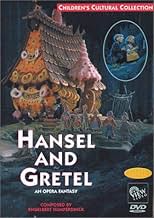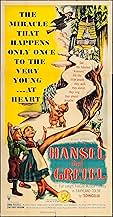Aggiungi una trama nella tua linguaAn "electronic puppet" version of the Humperdinck opera, adapted for children and using spoken dialogue as well as Humperdinck's music.An "electronic puppet" version of the Humperdinck opera, adapted for children and using spoken dialogue as well as Humperdinck's music.An "electronic puppet" version of the Humperdinck opera, adapted for children and using spoken dialogue as well as Humperdinck's music.
- Regia
- Sceneggiatura
- Star
- Premi
- 1 vittoria e 1 candidatura in totale
Mildred Dunnock
- Mother
- (voce)
Frank Rogier
- Father
- (voce)
Delbert Anderson
- Sandman
- (voce)
Helen Boatwright
- Dew Fairy
- (voce)
- (as Helen Boatright)
Constance Brigham
- Hansel
- (voce)
- …
Recensioni in evidenza
When I was growing up, we had a battered old VHS copy of this film that someone had had the presence of mind to tape off of the television one day. Even though I was born over twenty years after this film was created, it still captured my imagination and I remember watching it many times over with my older sisters.
This film is a retelling of the classic story of Hansel and Gretel, with a few whimsical additions and a musical score. The stop-motion animation used to create this film, is both primitive and charming at the same time. Although nowadays much smoother looking animation can be created on the computer, the claymation creatures in this film do not suffer in comparison, any more than claymation classics like Rudolph the Red-Nosed Reindeer.
The wonderful thing about this little film is the atmosphere created by the animated visuals, and by the lovely soundtrack. It's enchanting and creepy at the same time, which was an irresistible combination when I was a child. The cheerful parts are fun and engaging, while the more sinister scenes with the witch are wonderfully unsettling. Although it's been years since I've seen this film, to this very day I still remember the songs word for word and can recite from the script.
I think any child fond of fairy tales, or fantasy stories would enjoy seeing this little film. If you happen to see it on the television, or find it for sale somewhere, don't pass it up!
This film is a retelling of the classic story of Hansel and Gretel, with a few whimsical additions and a musical score. The stop-motion animation used to create this film, is both primitive and charming at the same time. Although nowadays much smoother looking animation can be created on the computer, the claymation creatures in this film do not suffer in comparison, any more than claymation classics like Rudolph the Red-Nosed Reindeer.
The wonderful thing about this little film is the atmosphere created by the animated visuals, and by the lovely soundtrack. It's enchanting and creepy at the same time, which was an irresistible combination when I was a child. The cheerful parts are fun and engaging, while the more sinister scenes with the witch are wonderfully unsettling. Although it's been years since I've seen this film, to this very day I still remember the songs word for word and can recite from the script.
I think any child fond of fairy tales, or fantasy stories would enjoy seeing this little film. If you happen to see it on the television, or find it for sale somewhere, don't pass it up!
Although this film may look like it was from Eastern Europe, it was definitely made in New York City. I was a member of the Apollo Boys Choir in 1953(we were from Palm Beach, Florida), and I remember visiting the studio in New York while the film was being shot. We came up from Palm Beach in the fall to record our part of the sound track. The choir director, Coleman Cooper, was a perfectionist, and we worked harder on this music than any other set of pieces I can remember. Unfortunately, by the time we got to New York we were pretty sung out. The recording session was long, and during it the producer decided that our sound needed some bolstering, so he brought in several female members of the Metropolitan Opera Chorus to help out. Mr. Cooper must have been very disappointed. This was an important project for him. We boys were a little disappointed too. I, at least, quickly got over it. The women, of course, were excellent singers, several were quite attractive, and they thought we were cute.
I found the other comments to be enlightening, especially with regard to the hurry-up conclusion.
However, I know for a fact that the boys' choir used in this movie was no a European choir, but the Apollo Boys Choir, originally of Palm Beach, Florida, that moved to Dallas, Texas until its director, Coleman Cooper, retired. It is unfortunately no longer in operation. During the Depression, the choir toured the United States in limousines, not buses, and sang for President Roosevelt at the Hot Springs resort where he escaped the pressures of Washington DC. The choir accompanist, Mr. Bert Hallack, is a resident of Palm Beach.
One famous former chorister of this choir is George Bragg, who founded the Texas Boys Boys (of Fort Worth).
However, I know for a fact that the boys' choir used in this movie was no a European choir, but the Apollo Boys Choir, originally of Palm Beach, Florida, that moved to Dallas, Texas until its director, Coleman Cooper, retired. It is unfortunately no longer in operation. During the Depression, the choir toured the United States in limousines, not buses, and sang for President Roosevelt at the Hot Springs resort where he escaped the pressures of Washington DC. The choir accompanist, Mr. Bert Hallack, is a resident of Palm Beach.
One famous former chorister of this choir is George Bragg, who founded the Texas Boys Boys (of Fort Worth).
Despite its European, "old world" look, Hansel and Gretel was made in New York City. Indeed the comments to the contrary are a tribute to the filmmakers' success in evoking a genuine fairy tale style. Nonetheless, the film was shot using conventional stop-motion puppets (notwithstanding the producer's claims to using some sort of mysterious "electronic" method) in the main room of an abandoned courthouse which is still standing at the corner of Second Avenue and Second Street in New York City. The large set was built in the main chamber on the second floor (now the largest of several theaters in what is currently (2005) the Anthology Film Archives).
Apparently electromagnets were used to hold the stop-motion puppets in place during some sequences, but normal procedures were used for the rest. This and some hype that lured in backers may account for the mistaken report that they are electronic puppets. They were solid, armature puppets and not clay (or "claymation") dolls.
The set survived the production and actually toured county fairs as a fairy tale exhibit for many years after the completion of the film.
Apparently electromagnets were used to hold the stop-motion puppets in place during some sequences, but normal procedures were used for the rest. This and some hype that lured in backers may account for the mistaken report that they are electronic puppets. They were solid, armature puppets and not clay (or "claymation") dolls.
The set survived the production and actually toured county fairs as a fairy tale exhibit for many years after the completion of the film.
Saw this a year ago.
It's a nice little musical, I like the songs and the old timey stop motion is pleasant. But dear lord, that mom needs child protective services called on her.
Also, the original version I saw it in was English, but I watched the Danish dub recently and apparently the witch is voiced by a guy? Interesting... wonder if that's the case for other dubs.
It's a nice little musical, I like the songs and the old timey stop motion is pleasant. But dear lord, that mom needs child protective services called on her.
Also, the original version I saw it in was English, but I watched the Danish dub recently and apparently the witch is voiced by a guy? Interesting... wonder if that's the case for other dubs.
Lo sapevi?
- QuizRe-released in 1972 as part of MGM's Children's Matinees package.
- ConnessioniFeatured in Animation Lookback: The Best of Stop Motion - The First Features (2014)
I più visti
Accedi per valutare e creare un elenco di titoli salvati per ottenere consigli personalizzati
Dettagli
- Data di uscita
- Paese di origine
- Lingua
- Celebre anche come
- Hansel and Gretel: An Opera Fantasy
- Luoghi delle riprese
- New York, New York, Stati Uniti(Studio)
- Azienda produttrice
- Vedi altri crediti dell’azienda su IMDbPro
- Tempo di esecuzione1 ora 12 minuti
- Mix di suoni
Contribuisci a questa pagina
Suggerisci una modifica o aggiungi i contenuti mancanti

Divario superiore
By what name was Hansel and Gretel (1954) officially released in Canada in English?
Rispondi



















